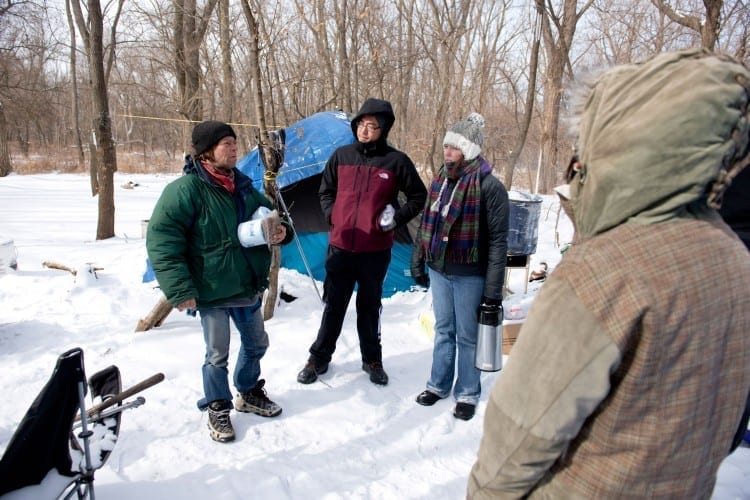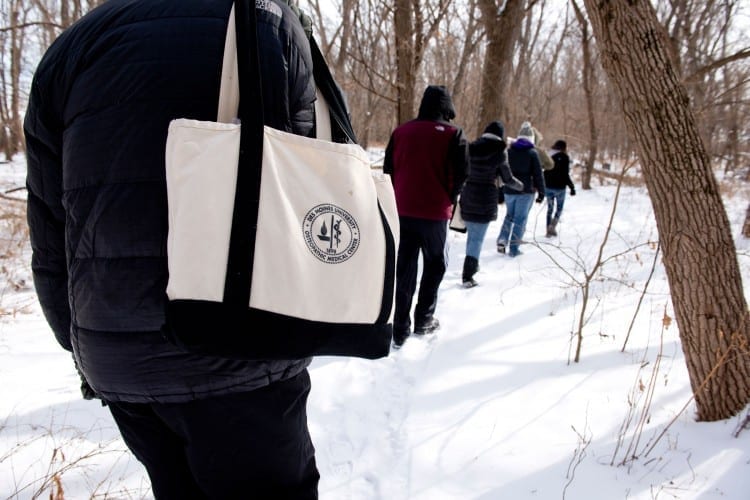
A recent early March morning in Des Moines was the kind that would make most medical students – most people, for that matter – hit the snooze button and crawl deeper under the covers.
Central Iowa was under yet another four inches of new snow; the temperature at 8:45 a.m. was barely above zero, with a wind chill nearly 20 degrees colder.
That didn’t deter 10 DMU students from gathering in the south hall of the Academic Center, where they divvied up toilet paper, batteries and other supplies into tote bags. Bundled up in parkas and snow pants, they were about to spend most of the morning outdoors.
“Thanks to you all for coming out this morning. We’ll split into two groups,” says Nisha Fahey, D.O.’16. “Our main goal is to get to know the people we see.”
The people they would see are among the state’s estimated 16,000-plus homeless, according to the Iowa Institute for Community Alliances. Every Sunday morning, students in DMU’s Homeless Camp Outreach (HCO) visit them in their tents and plywood structures tucked off city streets and along the Des Moines River. Students also visit formerly homeless individuals, with whom they’ve established friendships, who have found long-term housing.
“In the clinic, our role is very defined. But when we go on these visits, we work to establish personal, caring relationships that validate the campers’ dignity and humanity,” says Fahey, HCO president. “I have built such close relationships with many of them, which at first I didn’t think I would. I look forward to seeing them every week.”
HCO members have been offering warm hugs and cups of hot coffee to homeless individuals since the special-interest student organization was created nearly six years ago. The organization has grown to approximately 90 members who collectively volunteer an average of 60 hours per week. It’s added to its activities as well, including a regular shoe collection and participation in Reggie’s Sleep-out, an annual event designed to raise awareness and money to address youth homelessness in central Iowa.
“For medical students who are very busy, members of Homeless Camp Outreach are very dedicated,” says Kevin Carnevale, M.D., associate professor in microbiology and immunology and an HCO faculty adviser. He often joins the Sunday morning group and helps pay for the supplies they distribute.
When he was a medical student, Carnevale volunteered at a homeless men’s center in the Bronx, NY, during an era when many mental health institutions were being closed nationwide. He learned the extent to which “society is failing miserably” in helping people in need as well as the impact of reaching out to them.
“It’s very personal. When you work with people of different backgrounds, you come to understand your own value system. You’ve got to be able to put your biases aside to help people without passing judgment,” he says. “You also come home and realize how nice running water is.”
“Unsheltered” comes in many forms
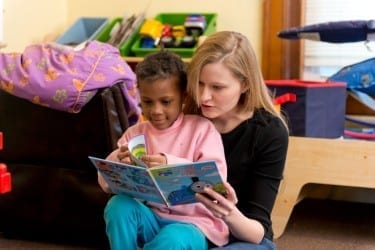
On a recent Monday evening, second-year osteopathic medical student and HCO member Kelsey Randel set aside her textbooks to join an energetic preschooler in building towers of Mega Bloks. They’re sitting on the living room floor of the New Directions Shelter of Hawthorn Hill, an organization that provides housing and services for homeless families with children.
The roomy house, located on Grand Avenue down the street from the DMU campus, is a welcome refuge for approximately 370 homeless mothers and their children every year. It can house up to eight families at a time, each of which may stay for up to 30 days. As an HCO outreach activity now in its second year, DMU students visit two evenings every week to play with the children.
“I think we picture homelessness as people camping, but it also includes people who are abandoned or without permanent shelter in other ways,” says Randel, HCO’s coordinator for the students’ New Directions visits.
While the DMU students enjoy interacting with the kids – “They’re so excited to see you; it’s instant gratification,” says HCO member Ifat Sattar, D.O.’16 – their playtime is helpful to the mothers at the shelter. It gives them time to work with case management staff on their resumés, job searches and applications, housing plans and other tasks.
That Monday evening, the social worker on staff reviewed the shelter’s services and policies with a new guest, her car-seated baby in tow, as Randel easily switched gears with her lively preschool friend. “Why don’t you go get a book?” she encourages. “Okay, Thomas the Train and the Jet Plane – that’s a good one.”

Coffee and conversations among friends
After they leave campus that bone-chilling Sunday morning, the students’ first stop is a convenience store on Ingersoll Avenue, where they fill up two large coffee urns. “We empty out their breakfast roast,” Fahey notes. HCO members take turns paying for the coffee. This Sunday, osteopathic medical student and HCO’s first-year liaison Katie McGough covers the tab.
“For me, it’s a matter of awareness and gratitude,” she says of her participation in the organization. “In medical school, it’s so easy to get lost, to get caught up in exam scores. This helps me remain grounded and helps me remember why I got into medicine.”
As the students pile into cars, one can’t help but think that remembering some medical knowledge of frostbite and hypothermia would be useful. Five students stomp through the snow in a lot on the city’s southside, calling out greetings to residents of a tarpaulin-covered tent. After a few minutes, Rhonda emerges and accepts a cup of coffee with a jovial “thanks, sweetheart.” Despite the face-ripping cold, she clearly enjoys chatting with the students.
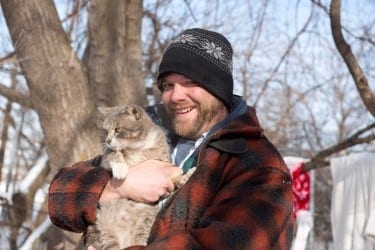
“I call them my medical kids,” she says. A few minutes later, Eric comes out of the tent to join the group. He thanks the students for the Ziploc bag of cat food they’ve brought for the couple’s gray tabby, Camper. Rhonda, meanwhile, asks the students which system of the body they’re learning about. She’s pleased to learn HCO has kept the boxed set of The New Illustrated Medical Encyclopedia for Home Use – circa the late 1950s – that she found and gave to the group.
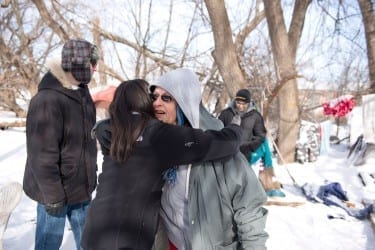
After living in a tent for almost a year, Rhonda knows some camping areas are less safe than their current location. But even with the obvious hardships of being “houseless” – from the isolation and challenges of seemingly simple tasks such as toileting and laundry to more overwhelming matters such as obtaining health care and Eric’s unemployment payments – Rhonda expresses gratitude: for the church congregation in Zearing, IA, that brought them tents. For the property owner who doesn’t hassle them. For Joppa Outreach, a local nonprofit organization that provides them with necessities including the propane they use to heat their tent. And for the DMU students who’ve given them more than cat food and D batteries. She embraces each one before they head back to their cars.
“These kids have been wonderful company,” Rhonda says.
Lessons learned from the unsheltered
While HCO members’ outreach activities are acts of kindness committed without expectation of reward, the students describe lessons their unsheltered friends have given them. First, there are as many reasons people become homeless as there are homeless people, so leave your stereotypes at the door – or the tent flap.
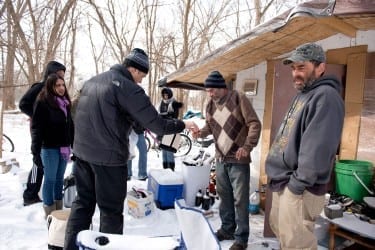
Katie McGough adds, “I would say the biggest misconception across the board is that these people aren’t trying. But it’s not like that. You realize becoming homeless can happen to anyone.”
That doesn’t mean the students don’t see the self-inflicted problems and poor lifestyle choices of some unsheltered individuals. Judging or dismissing them out of hand, however, is the wrong approach for future health care providers, students say. Rather, they want to learn to work with patients whatever their situation and realities of their lives, good or bad.
“I think it’s so important for students to realize there are so many factors affecting a person’s life outside what’s happening in the doctor’s office,” Nisha Fahey says. “It’s important that we be open-minded and recognize those factors and the role they play in a person’s health. That includes understanding barriers. We can provide better care if we understand when a patient has those issues, such as access to transportation and housing.
“For unsheltered individuals, the smallest tasks of daily life can consume so much time, energy and planning,” she adds. “You need your basic necessities before you can think about your long-term health.”
Among those basic necessities: footwear
Third-year DMU student Jason Havey likes to run. Before he enrolled in the College of Podiatric Medicine and Surgery, he spent a year coaching track and cross country at the University of Minnesota. For several years he managed a sporting goods store in Minneapolis, which collects and recycles used athletic shoes for distribution to people who need footwear.
“While I might not recommend running miles and miles in a pair of used running shoes, they typically have so much life left in them,” he says.
That’s why Havey was particularly struck by an individual he met during a Sunday morning HCO outing last year: “He was wearing old work boots. His toes were all cramped up inside because the boots were a size 10, and he’s a 12 to 12 and a half. Here I am, size 12 and a half, with several pairs of shoes,” he recalls. “The next week, I took him a pair of my shoes. When I went out again, he was wearing them.”
Havey also connected with some of his former Minneapolis colleagues to assemble of box of used shoes, which he packed into the industrial washer at a laundromat near the DMU campus. Now, HCO has a box for donated shoes at Fitness Sports Ltd., 7230 University Ave., in the Des Moines suburb of Windsor Heights. And Havey has insights thanks to his HCO experiences.
“Most of us are used to a lifestyle that’s so different from what homeless people are living. It’s good to remind ourselves that things aren’t as bad as we might make them out to be. We can lose all touch with reality as medical students,” he says.
That contrast doesn’t make unsheltered individuals any less human or worthy, he adds. As a physician, he plans to consider his patients’ situations in planning and providing their care.
“I plan on treating all people of different social statuses, so any opportunity to interact with people of different demographics is a really good opportunity,” Havey says. “How can I help a patient be fully compliant and improve his health when he’s homeless? Let’s say I want him to put his legs up on the couch every evening. But he’ll need a different approach if he’s living in a tent.”

An “eye-opening experience”
As a first-year osteopathic medical student, Jacob Thomas became interested in HCO after second-year students told him its activities enhanced their patient interviewing and history-taking skills. But the first time he joined the Sunday morning group, he was “really uncomfortable.”
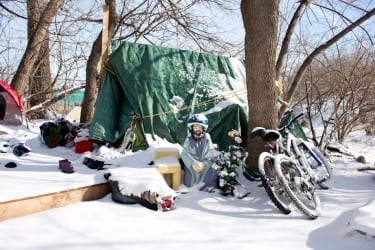
Thomas chose the latter: Now the organization’s vice president, the second-year student says talking with homeless individuals has been “a really amazing and eye-opening experience.”
It’s likely one that will change participating students as health care professionals and as people. Early that Sunday morning in March, Des Moines television stations reported that the 150 emergency-shelter beds of the Central Iowa Shelter and Services facility, opened in 2012, were occupied, with another 100 homeless individuals sleeping in chairs. The forecast for that evening was five to 10 degrees below zero, with wind chills about 20 degrees lower; meteorologists were predicting more mind-numbing cold and snow for much of the month ahead.
“What makes Homeless Camp Outreach possible are passionate people,” Thomas says. “We’re in dire need of more of them.”

